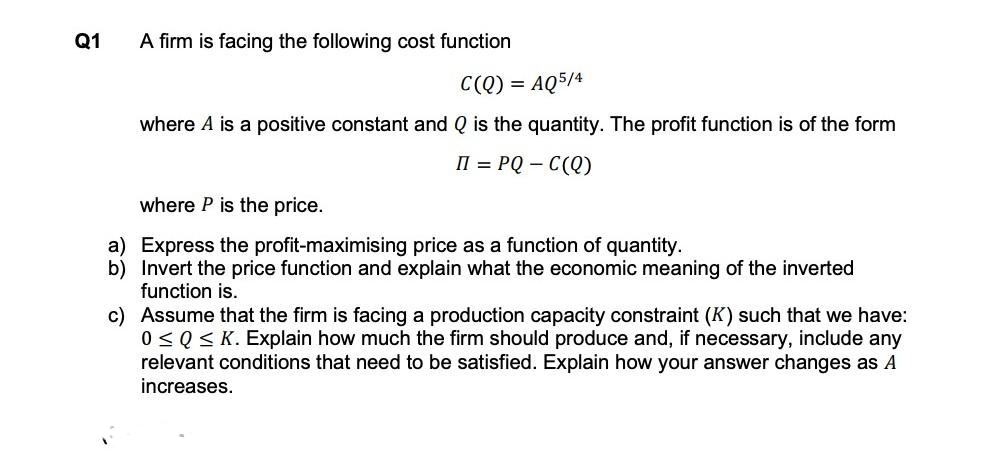Q1 A firm is facing the following cost function C(Q) = AQ5/4 where A is a positive constant and Q is the quantity. The profit function is of the form II=PQ-C(Q) where P is the price. a) Express the profit-maximising price as a function of quantity. b) Invert the price function and explain what the economic meaning of the inverted function is. c) Assume that the firm is facing a production capacity constraint (K) such that we have: 0 ≤ Q≤ K. Explain how much the firm should produce and, if necessary, include any relevant conditions that need to be satisfied. Explain how your answer changes as A increases.
Q1 A firm is facing the following cost function C(Q) = AQ5/4 where A is a positive constant and Q is the quantity. The profit function is of the form II=PQ-C(Q) where P is the price. a) Express the profit-maximising price as a function of quantity. b) Invert the price function and explain what the economic meaning of the inverted function is. c) Assume that the firm is facing a production capacity constraint (K) such that we have: 0 ≤ Q≤ K. Explain how much the firm should produce and, if necessary, include any relevant conditions that need to be satisfied. Explain how your answer changes as A increases.
Managerial Economics: Applications, Strategies and Tactics (MindTap Course List)
14th Edition
ISBN:9781305506381
Author:James R. McGuigan, R. Charles Moyer, Frederick H.deB. Harris
Publisher:James R. McGuigan, R. Charles Moyer, Frederick H.deB. Harris
ChapterB: Differential Calculus Techniques In Management
Section: Chapter Questions
Problem 5E
Related questions
Question
Please provide all solution if you attempt this otherwise don't attempt it

Transcribed Image Text:Q1
a)
b)
A firm is facing the following cost function
C(Q) = AQ5/4
where A is a positive constant and Q is the quantity. The profit function is of the form
II = PQ-C(Q)
where P is the price.
Express the profit-maximising price as a function of quantity.
Invert the price function and explain what the economic meaning of the inverted
function is.
c) Assume that the firm is facing a production capacity constraint (K) such that we have:
0 ≤ Q≤ K. Explain how much the firm should produce and, if necessary, include any
relevant conditions that need to be satisfied. Explain how your answer changes as A
increases.
Expert Solution
This question has been solved!
Explore an expertly crafted, step-by-step solution for a thorough understanding of key concepts.
Step by step
Solved in 2 steps

Knowledge Booster
Learn more about
Need a deep-dive on the concept behind this application? Look no further. Learn more about this topic, economics and related others by exploring similar questions and additional content below.Recommended textbooks for you

Managerial Economics: Applications, Strategies an…
Economics
ISBN:
9781305506381
Author:
James R. McGuigan, R. Charles Moyer, Frederick H.deB. Harris
Publisher:
Cengage Learning


Managerial Economics: Applications, Strategies an…
Economics
ISBN:
9781305506381
Author:
James R. McGuigan, R. Charles Moyer, Frederick H.deB. Harris
Publisher:
Cengage Learning
